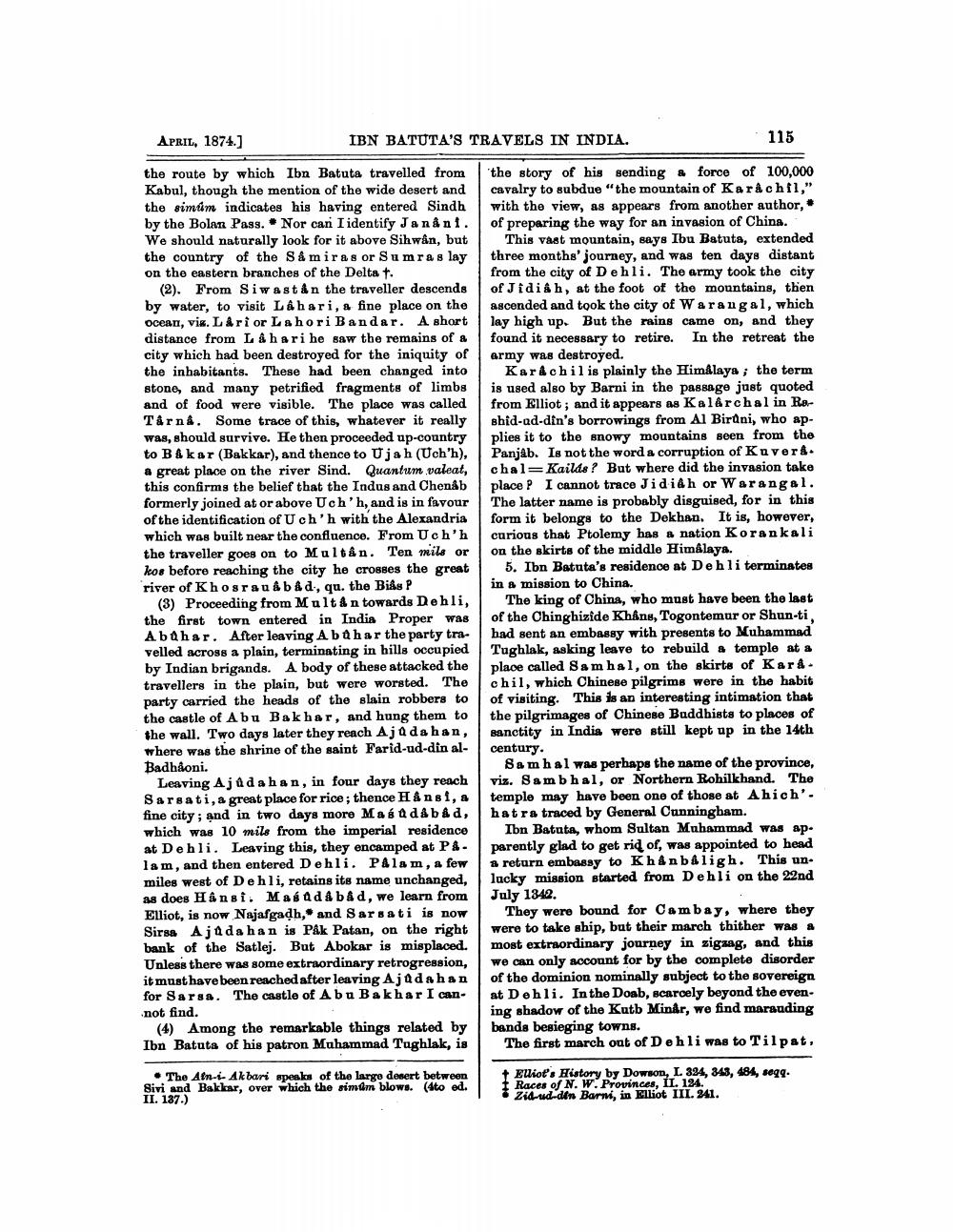________________
APRIL, 1874.]
IBN BATUTA'S TRAVELS IN INDIA.
115
the route by which Ibn Batuta travelled from Kabul, though the mention of the wide desert and the simúm indicates his having entered Sindh by the Bolan Pass. * Nor can I identify Jana ni. We should naturally look for it above Sihwân, but the country of the Så miras or Sumras lay on the eastern branches of the Delta t.
(2). From Siwastan the traveller descends by water, to visit Lahari, a fine place on the ocean, vik. Lari or Lahori Bandar. A short distance from Lahari he saw the remains of a city which had been destroyed for the iniquity of the inhabitants. These had been changed into stono, and many petrified fragments of limbs and of food were visible. The place was called Tarna. Some trace of this, whatever it really was, should survive. He then proceeded up-country to B & kar (Bakkar), and thence to Ujah (Uch'h), a great place on the river Sind. Quantum valeat, this confirms the belief that the Indus and Chenab formerly joined at or above Uch'h, and is in favour of the identification of U ch'h with the Alexandria which was built near the confluence. From Uch'h the traveller goes on to Multân. Ten mils or kos before reaching the city he crosses the great river of Khosrau & båd, qu. the Bias P
(3) Proceeding from Multa n towards Dehli, the first town entered in India Proper was AbQhar. After leaving Abohar the party tra- velled across a plain, terminating in hills occupied by Indian brigands. A body of these attacked the travellers in the plain, but were worsted. The party carried the heads of the slain robbers to the castle of Abu Bakhar, and hung them to the wall. Two days later they reach Ajadahan, where was the shrine of the saint Farid-ud-din alBadhảoni.
Leaving Ajad ahan, in four days they reach Sarsati, a great place for rice; thence Hansi, a fine city, and in two days more MadAbad, which was 10 mils from the imperial residence at Dehli. Leaving this, they encamped at PA. lam, and then entered Dehli. PAlam, a few miles west of Dehli, retains its name unchanged, as does Hansi. Masad å båd, we learn from Elliot, is now Najafgadh, and Sarsati is now Sirsa Ajudahan is Påk Patan, on the right bank of the Satlej. But Abokar is misplaced. Unless there was some extraordinary retrogression, it must have been reached after leaving Ajudahan for Sarsa. The castle of Abu Bakhar I cannot find.
(4) Among the remarkable things related by Ibn Batuta of his patron Muhammad Tughlak, is
the story of his sending & force of 100,000 cavalry to subdue "the mountain of Karachil," with the view, as appears from another author, of preparing the way for an invasion of China.
This vast mountain, says Ibu Batuta, extended three months' journey, and was ten days distant from the city of Dehli. The army took the city of Jidish, at the foot of the mountains, then ascended and took the city of Warangal, which lay high up. But the rains came on, and they found it necessary to retire. In the retreat the army was destroyed.
Karachil is plainly the Himalaya ; the term is used also by Barni in the passage just quoted from Elliot; and it appears as Kalarchal in Roshid-ad-din's borrowings from Al Biruni, who applies it to the snowy mountains seen from the Panjab. Is not the word a corruption of Kuvers. chal=Kailds ? But where did the invasion take place P I cannot trace JidiAh or Warangal. The latter name is probably disguised, for in this form it belongs to the Dekhan. It is, however, curious that Ptolemy has a nation Korankali on the skirts of the middle Himalaya.
5. Ibn Batuta's residence at Dehli terminates in a mission to China.
The king of China, who must have been the last of the Chinghizide Kháng, Togontemur or Shun-ti, had sent an embassy with presents to Muhammad Tughlak, asking leave to rebuild a temple at a place called Samhal, on the skirts of Kars. chil, which Chinese pilgrims were in the habit of visiting. This is an interesting intimation that the pilgrimages of Chinese Buddhists to places of sanctity in India were still kept up in the 14th century.
Sam hal was perhaps the name of the province, viz. Sambhal, or Northern Rohilkhand. The templo may have been one of those at Ahich'. hatra traced by General Cunningham.
Ibn Batuta, whom Sultan Muhammad was ap. parently glad to get rid of, was appointed to head 3 return embassy to Khånbaligh. This un. lucky mission started from Dehli on the 22nd July 1342
They were bound for Cambay, where they were to take ship, but their march thither was a most extraordinary journey in zigaag, and this we can only account for by the complete disorder of the dominion nominally subject to the sovereign at Dohli. In the Doab, scarcely beyond the evening shadow of the Kutb Minar, we find marauding bands besieging towns.
The first march out of Dehli was to Tilpat.
• The Al-Akbari speaks of the largo desert between Sivi and Bakkar, over which the simum blows. (4to ed. II. 187.)
+ Eliot's History by Dowson, L 334, 343, 484, segg.
Races of N. W. Provinces, II. 124. Zid-ud-din Barni, in Elliot IIL. 341.




